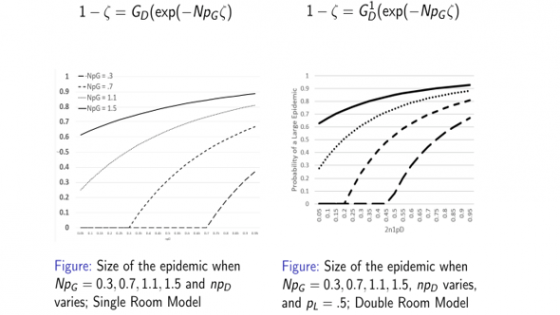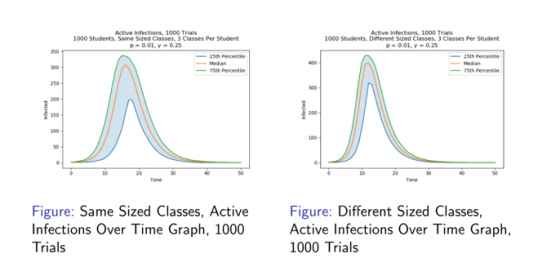Project leader: Professor Rick Durrett
Project manager: Ray Tung
Team members: Molly Borowiak, Fayfay Ning, Justin Pei, Sarah Zhao
This project has produced the following published paper:
Molly Borowiak, Fayfay Ning, Justin Pei, Sarah Zhao, Hwai-Ray Tung, Rick Durrett, Controlling the spread of COVID-19 on college campuses, Mathematical Biosciences and Engineering volume 18, issue 1, 551-563.
Of the basic epidemic models on graphs that can dynamically represent social networks in homogeneously mixed populations, the most relevant is the SEIR model. Individuals are first classified as Susceptible to disease, later reclassified as Exposed (if they have the disease but show no symptoms), Infected (if they have the disease and are contagious), and finally Removed (if either recovered from the disease or in quarantine or in the hospital). In our project we further extended the question of Covid-19’s impact to college campus policies, investigating a number of questions but here highlighting only two.
How would the size of an epidemic spread be reduced if Duke placed all students in single rooms? To answer this question, we generalized the Household model, also known as the Clumped Reed-Forest Model, to a Dorm model. Our Dorm model included three levels to simulate the local and global probabilities that any given student infects their roommate, their dorm, and the campus. Computations for a branching process approximation of final epidemic size using generating functions showed that the reduction would be substantial.
How would reducing class sizes to online instruction affect epidemic spread? A recent study simulated a complicated individual based model of a private university and suggested the optimal strategy to minimize epidemic spread is to move classes larger than 50 students to online instruction. To investigate this claim, we created a simple model of infection spread due to classroom contact. Using simulations, we found different class sizes, as opposed to uniform class sizes, causes the outbreak to develop faster, have a higher peak, and vary less. The two graphs compare a university in which all classes have size 30, with one that has a mixture of classes of size 60 and some of size 20. To investigate the claim that 50 is the optimal cutoff, we investigated a situation in which there are classes of size 10, 11, … 110. Our results show that the optimal cutoff depends on the infection probability.


